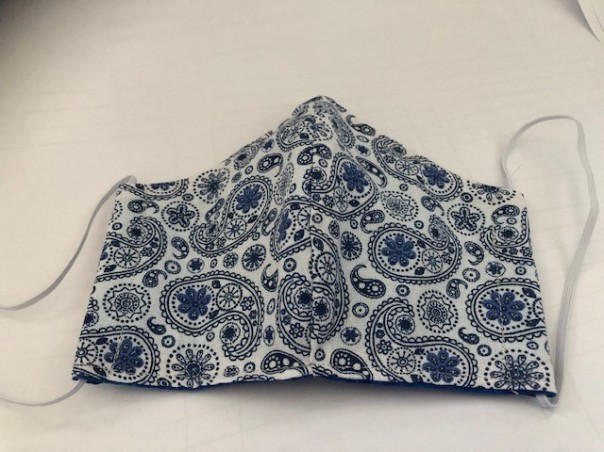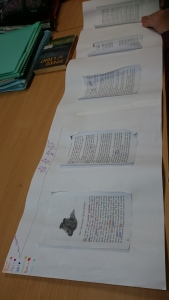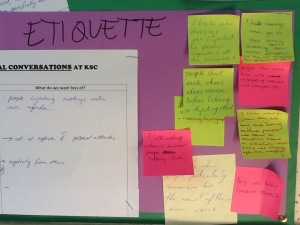Step Up or Shut Up!
I survived 2020 – the (first) year of the COVID19 pandemic!
I think it is important to write this down somewhere for posterity, so here it is. I survived the most difficult year of my personal and professional life. So, for the first two weeks of 2021, I decided to give myself a break and take some time to slow down and think about things.
Teaching is my passion … February 2021 will mark the start of my 30th year of teaching. I love being in the classroom with the students and I love being around my colleagues planning, sharing and debating about anything to do with education. The reason I began this blog was as a direct result of a conversation with some less experienced colleagues around a staffroom table when they encouraged me to share my experiences, ideas and observations with a wider audience. It wasn’t until I gave myself some time for reflection and decided to revisit some of my posts that I realised, with sadness, that it has been two years since I have posted on my blog. I was very surprised to see that I did not even have any draft posts on the go … although I regularly make notes in margins and on PD handouts for potential blog topics. I know I have had inspiration so why have I let two years pass by without sharing my observations, thoughts and wonderings?
The honest truth is that in this time I made the shift from being a classroom teacher to being a Principal. I am lucky that in my current situation, a small rural primary school, I actually still get to do both roles: I teach a grade 3-6 composite for Literacy and Numeracy four days a week but I am the Principal of the school full-time. While I could, and would like to, get back to sharing my ideas from the classroom, a lot of my wonderings and debates are about issues beyond the classroom. I find myself wrestling with the politics of leadership! On one hand I believe in the right to freedom of speech and that honest, open debate is healthy for democracy, on the other I also have an obligation to ‘toe the party line’ and not to ‘rock the boat’ too much as a representative of the Department of Education. By the time I have considered these angles I find I have lost the momentum for blogging! Early in my career I was asked by an Assistant Principal (who became a mentor to me) if I had ambition to be a Principal. I said ‘No’. However, as the years passed and I became disenchanted with some of the leadership practice I saw. I realised I had one choice … Step up or shut up! How ironic that after stepping up to a principal position I find myself less inclined to speak out and share my ideas. So, one of my goals in 2021 is to wrestle less and write more.
Circling back to 2020 with the lockdowns, restrictions and constant stream of changing information I find myself looking at the leadership behaviour I have witnessed around me and how this has influenced me. The driving question I ask myself as I start each year is “What makes a good teacher?” I strive to find the answer as I strive to become a good teacher. I now also find myself asking “What makes a good leader?”
The good leaders I have seen in 2020 have not always made popular decisions, or taken easy options, or had all the answers in the press conferences and media releases, they have not hidden away in offices or holiday homes … they have turned up to face the questions, they have considered a wide variety of evidence before making decisions, they have stuck with a plan for long enough to see if it works but been prepared to change if there is evidence that supports a change, they have considered the needs of their communities even if it meant following a different plan than leaders of other communities. Good leaders or not, they all face criticism from the sidelines. Stepping up into leadership means opening yourself to criticism – the trick is to decide which voices to listen to!
Now it’s time to look forward to the new school year. I don’t really do New Year resolutions but I do try to set some personal and professional goals. In this week’s #TLAPdownunder Twitter chat we were asked for our one word for 2021 … my answer, COURAGE! I came out of 2020 as a much stronger leader and I go into 2021 with more confidence as a result. Oh, and of course, I am looking forward to the chatter and challenges my students will bring to our classroom.
Going Global
This year I took on the challenge not only of being Principal of a Primary School but also teaching a composite grade 3-6 class. I’m lucky, it’s a small school! I have 8 highly motivated, independent learners and a fantastic community of supportive parents.
So I decided to have my first go at something I have been aware of for years but not had the ideal opportunity to engage in: The Global Read Aloud.
The concept is simple – schools around the world read the same book at the same time and connect with each other.
The “read aloud” bit did not phase me, but the “connect” bit was a mystery and little daunting. What does connect mean? When I joined the Facebook groups the teachers talked a new language of flipgrids, google hangouts and mystery skypes. I was somewhat overwhelmed but committed to a postcard exchange and the slow chat on twitter.
Then, one night, I happened to be online on twitter while schools in the USA were tweeting live: 10 am in the USA, 12 am in Australia. I told my students about the experience and they began to buzz. Could we have sleepover at school and then they could join in?

So we did!
Thanks to daylight saving 10 am Friday USA became 1 am Saturday Australia. We joined the twitter live chat for 30 mins and then spent another 40 mins on a skype call I had set up with a small school in America.
My students were so motivated after this, they set up their own padlet to ask questions for students from around the world to answer, they checked the mail every day awaiting the next postcard delivery, they listened to the weekly video post by the author answering questions about the novel, they researched Pakistan and the new vocabulary we were exposed to … without me directing them to.
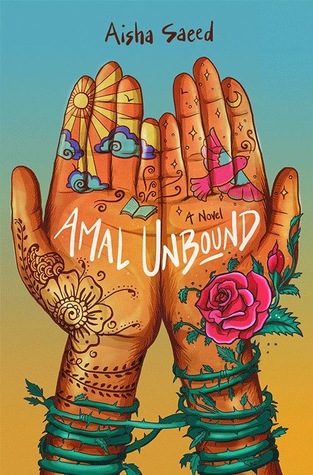 We have just finished the novel we chose to read (Amal Unbound). All we did was listen as I read and share our wonderings and thoughts. We didn’t do any major study or tasks (although you could if you wanted to, the Facebook community are great at sharing resources.)
We have just finished the novel we chose to read (Amal Unbound). All we did was listen as I read and share our wonderings and thoughts. We didn’t do any major study or tasks (although you could if you wanted to, the Facebook community are great at sharing resources.)
The students have enjoyed it so much they are already planning for next year so we can make more “connections”.
Wherever you are in the world, whatever grade you teach, why not give GRA a go?
It is great way to give your students a real sense of global citizenship.
Clues in the Classroom
Last year my year 7 English class developed a serious habit of playing Cluedo in our weekly games session. It gave me an idea based on the “How to Host a Murder” games about playing our own game of Cluedo.
I would write a mystery and reveal clues and they would have to solve it. I did the usual google research and gathered ideas from many sources before I began to sketch out my plan.
I started with a crime scene created in a classroom. As part of the initial reveal I gave the students the front page of the newspaper which had the report of an “incident” at the school (I created this using MS Publisher) and an article about bullying (although they didn’t pay much attention to this at this point).
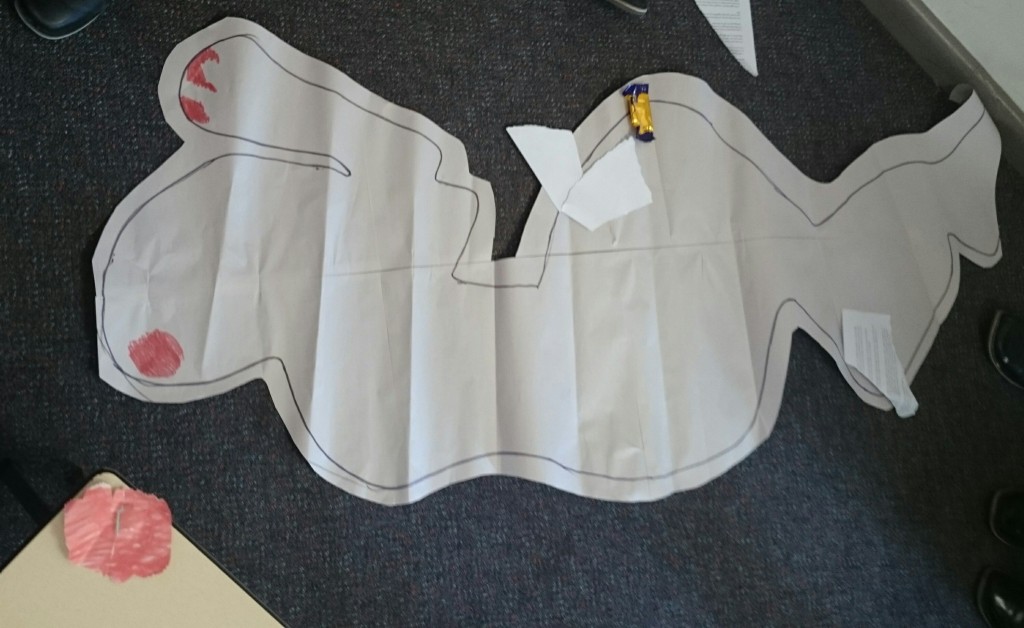
The initial crime scene … unfortunately I didn’t have time to make fake blood so red patches had to do!
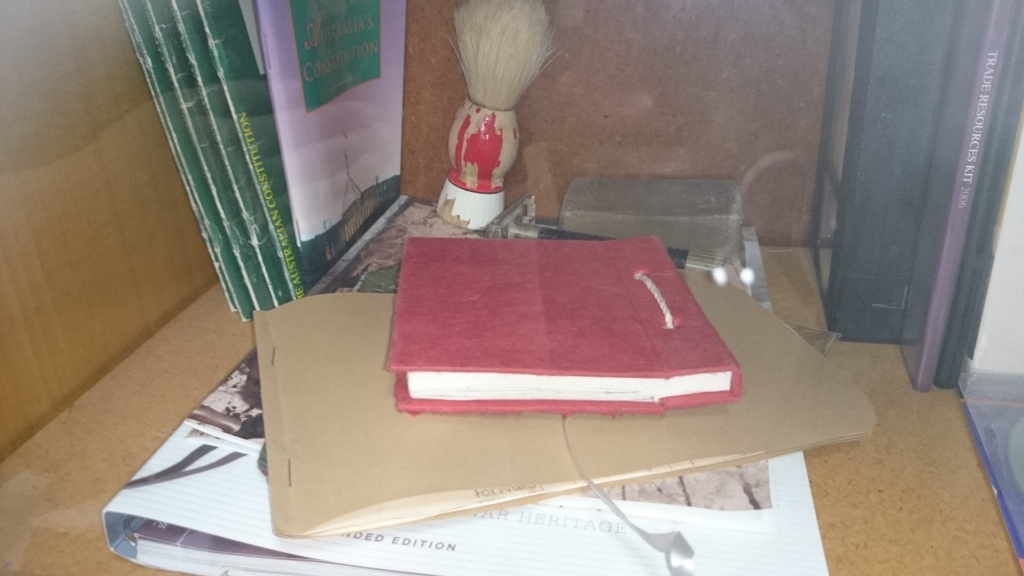
One of the lockers set up with diary and lots of misleading clues to work through.
Over the next week more clues were revealed. I set up lockers for each of the characters with clues and red-herrings. I added Facebook style pages and (fake) school webpages showing the results of surveys about bullying … these were made in MS Word and saved as webpages -students accessed them from our school server.
At the end of the week the coroner’s report was released – this prompted a lot of research to decipher medical terms and challenging language.
Then came the interviews. I acted as the characters and the students were the police detectives who interrogated me.

We used see-think-wonder to review our clues / evidence.
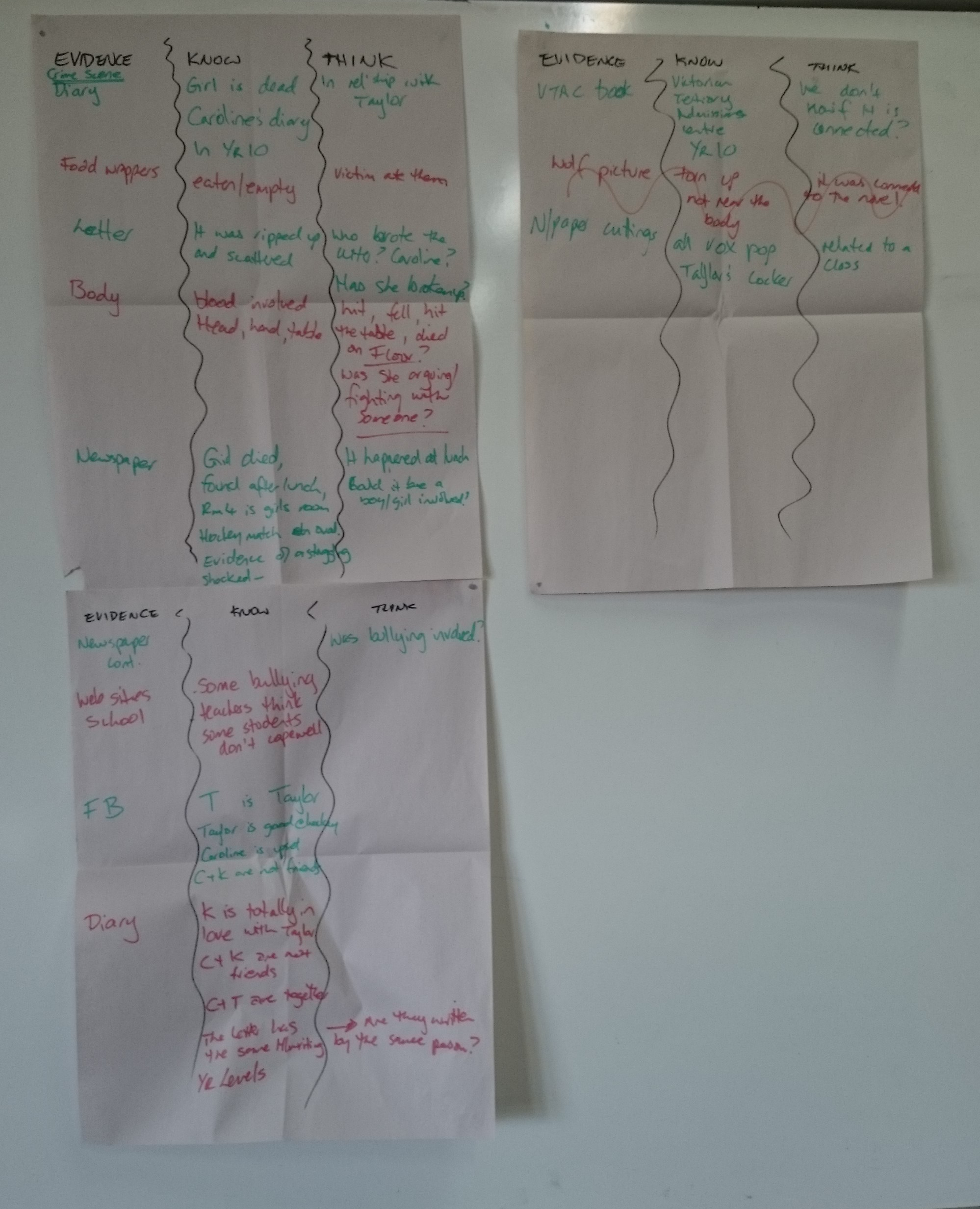
It didn’t take long for the enthusiasm to spread throughout the whole school – and not just the year 7s were talking about and trying to solve the mystery.
After three weeks I asked each of the year 7s to write their solution to the mystery including the evidence that led them to that conclusion. Then I revealed the answer.
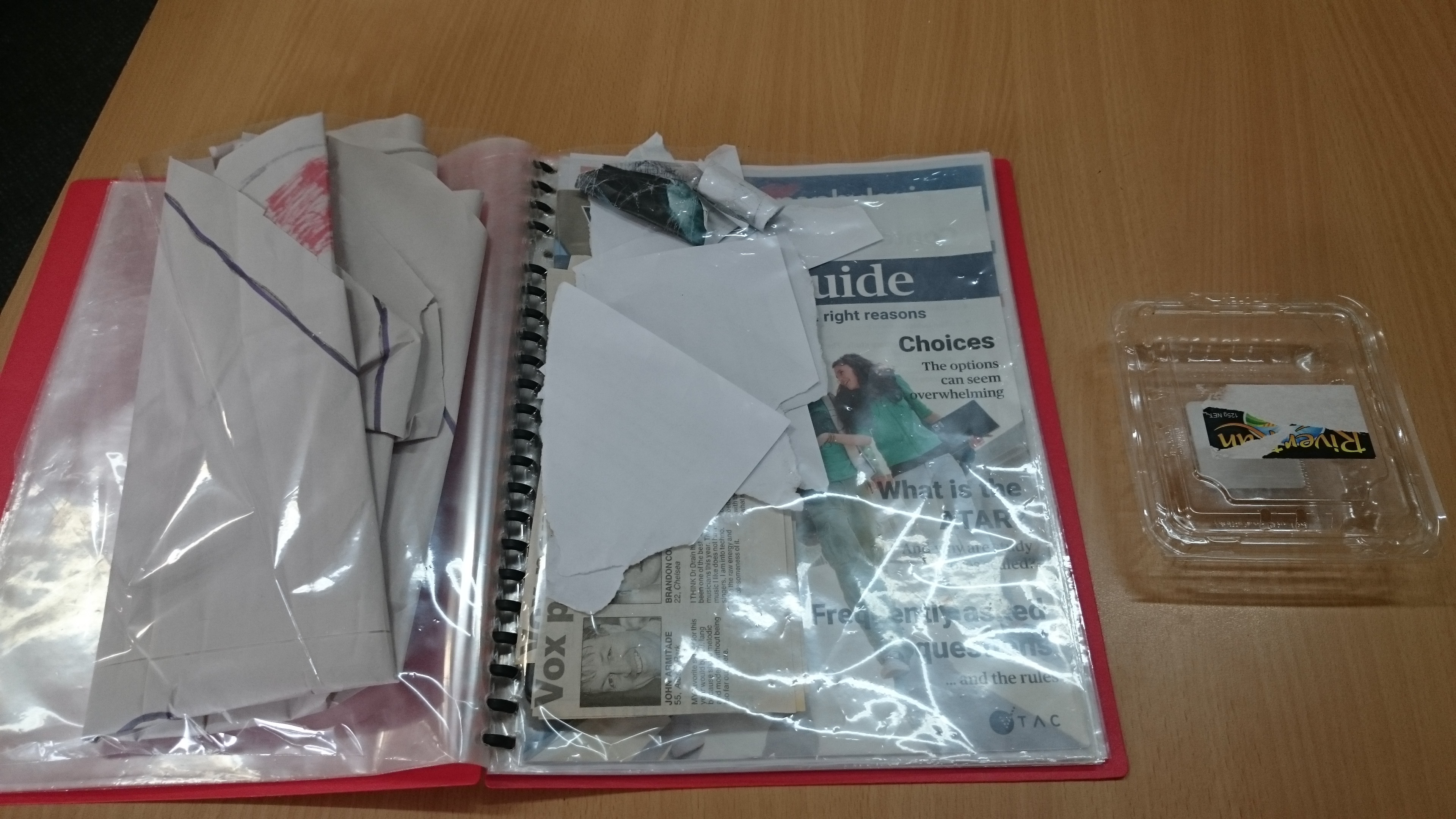
The students kept all the clues they gathered in a folder. This included photos of the crime scene and lockers before they moved anything. They could unpack and review the information at any time during the process.
Then the students decided to have a go themselves at creating a mystery with the intention of giving it to the class this year to solve.
It was a great way to cover a variety of texts types, to look at explicit and inferred information, to develop questioning techniques and explore issues such as bullying, influence of social media and cyber-safety. At the end of each week they reviewed the clues they had collected and developed new theories – this was the ideal place to teach discussion protocols that ensured everyone in the class had a chance to express their ideas. When they created their own mystery they had the chance to create the various text types with an authentic audience in mind. They filmed police interviews with their characters and wrote instructions about how and when to reveal the clues.
However, this year I changed schools, so I don’t know if the mystery they wrote was ‘played’
.
Picturing Poetry
Today I’m sharing the successful lesson of a colleague! Our Grade 3-6 teacher wanted to do some poetry as part of her Literacy block. Like many Literacy/English teachers she felt a little overwhelmed about where to start and, since we have planning time together, we often work through ideas and so we put our heads together on this.
I expressed my concern about how teachers usually jump in to getting students to write poetry without actually teaching them any of the structure and features (admitting that I am a Literature snob!). Haiku, limericks and acrostics seem easy because they are structured but what about the imagery and vocabulary that form the foundation? She expressed her concern about not having confidence in her ability to interpret poetry and doubts about whether this age group would cope.
We checked out a few of my favourites, which I selected because of the figurative language and imagery. We came up with a plan to break them down stanza by stanza (introducing metalanguage). Students would identify parts of speech with particular focus on nouns and adjectives. They would then draw pictures using these words to prompt their imaginations and write a short explanation, in plain English, to tell the story.
So, effectively we were asking grade 5 and 6 students to analyse poetry that I would normally give to my year 11 VCE students.
Today she shared a couple of pieces of work from the grade 5s … and I was blown away! Using the poem “The Sleepout” by Les Murray her students totally proved that if you set high expectations students will do their best to achieve them.

What I like about this is that the student ‘gets’ the blurring between reality and imagination … notice how the walls dissolve and become part of the forest?
* * *
How do you tackle poetry in your Literacy/English sessions?
Look after yourself first!
 We are about to head into the final quarter of the 2017 school year in Australia and planning for 2018 has begun. February 11th 2018 will be the starting bell for my 28th year of teaching … and some recent conversations with a graduate teacher made me think about how we keep our own engagement in our profession going.
We are about to head into the final quarter of the 2017 school year in Australia and planning for 2018 has begun. February 11th 2018 will be the starting bell for my 28th year of teaching … and some recent conversations with a graduate teacher made me think about how we keep our own engagement in our profession going.
I was in the SES (State Emergency Service) for five years. As a first responder it is drummed into you that you need to look after yourself first, and sometimes that means not rushing in to help victims. I think this is also true for teachers. We get so focused on our students and their needs we forget our own. It is easy to get swept up in curriculum, administration and day-to-day happenings and teacher burnout is a real thing! We need to look after ourselves first!!
I confess that not all of my 28 years have been enjoyable (although I wouldn’t trade any of the experiences – they have all shaped me into the teacher I am today). I have been stressed, depressed, exhausted, frustrated, bored, elated, excited and proud. There have been plenty of times I have questioned if I should change careers but I am still here.
I reminded my younger colleague that we are only paid to work 38 hours a week! We all know that good teachers spend waaay more than that time planning and preparing lessons and resources … but we need to remember that this is a choice. It is also a perfectly acceptable choice to say, I have a life outside of teaching! My ‘time-out’ is craft work – patchwork, quilting, knitting, crocheting, sewing, scrapbooking, soap-making, etc. My sister (also a teacher) has taken to running – she is currently on track with training for her first marathon! We also have a weekly (sometimes more) ritual at my current school of heading to the coffee shop at the end of the day. It could be a group of two or ten – but the conversation about school doesn’t last long, we move on to everything from town gossip to current affairs.
The important thing is to take time out to enjoy the things you like to do. You need to keep your interests alive and this will keep your energy and creativity going. We encourage our students to do this!!
During official working hours, I look for opportunities to challenge myself. If you find yourself falling into the trap of teaching the same thing year after year, you need to stop and change. I am lucky that I am teaching in a small school at the moment so I have the luxury of each class being an entire year level. However, in the past, at larger schools, even when I was one of six classes in the same year level, I could still challenge myself to do things differently.
Teaching is a collegiate activity – I enjoyed working in teams and thrashing out new ideas and activities. In my small P-12 school my graduate colleague and I have devised an interesting project for term four. She teaches a grade 3-6 composite and we have planned a literacy programme together (some of which we plan to team teach) based on Roald Dahl’s The BFG. For both of us this is a challenge and an opportunity – as secondary English teacher I bring different ideas, strategies and approaches compared to my primary colleague – we are excited about learning from each other, and I look forward to starting to build relationships with students who will be in my classes in the future.
I also volunteer my time to be a mentor in the Student Blogging Challenge … this year will be my second time around! My current students are mostly from the USA but in the past I have mentored students from Ireland, UK and Russia. This has also meant I have made connections with teachers from those schools. Opportunities like this, along with a healthy PLN on twitter, means I have discussions about teaching and education on a global scale.
So:
- What are you doing to keep your enthusiasm going in 2018? A new perspective? A new role? A new job?
- What are you doing to look after yourself in 2018? hobbies, interests, time-out? When was the last time you read a book, went to a movie or took a holiday?
A novel approach
 As part of my performance development plan this year I am working with a colleague to build students’ strength and confidence in the area of text response. Our focus group is her Year 10 class as we prepare them to enter their VCE next year. I am currently teaching both levels (Years 11 and 12) of VCE English and in both classes we are getting our teeth into the comparative texts.
As part of my performance development plan this year I am working with a colleague to build students’ strength and confidence in the area of text response. Our focus group is her Year 10 class as we prepare them to enter their VCE next year. I am currently teaching both levels (Years 11 and 12) of VCE English and in both classes we are getting our teeth into the comparative texts.
This has led me to again ponder the age old debate about how / when to read the texts.
In Year 12 our comparative texts are “Year of Wonders” by Geraldine Brooks and “The Crucible” by Arthur Miller … in Year 11 – “Macbeth” by Shakespeare and the film text, “Paradise Road”. The novel, “Year of Wonders” is a relatively easy read, so I felt the Yr 12s should have been able to read this at home. We are time poor in class and it seems extravagant to use up that time just to read when students can do that themselves, but can they? I knew my Yr 11s would struggle with Shakespeare and I had always planned to ‘read’ this in class with them. I always listen to a radio play when I do Shakespeare. I asked the Yr 12s to try to read “The Crucible”, I expect to read any play together and stage some of the scenes.
What I constantly wrestle with is the idea that we suck the fun out of learning, and specifically out of reading!
In Yr 7 we read “Red Dog” by Louis de Bernières. As this was their first text study in High School I read it to them. I wanted to model my wonderings (how I think when I read) and how to annotate a text. But if I’m being honest, I was also being a little selfish and indulgent. I like to read. I enjoy listening to a good reader read (my mother read to my sisters and me when we were younger and I still enjoy a good talking book). I want my students to enjoy reading. I also want them to think about what they read and react to it.
So, I indulged my yr 12s! I gave them the choice to read the novel themselves and do the chapter questions and theme pages …blah, blah, blah … or to sit with me on the comfy couches in the library and read. Initially one said he preferred to go it alone but it didn’t take long before he caved and joined us on the couches. We took about 6 lessons to read the text, with some negotiated home-alone reading. What we had along the way was some great sharing of wonderings, thinking out loud, making text connections, predicting the plot and reacting with emotion. We don’t need to ‘do the assignment’ (although we did make annotations as we read) and I know the students get the big ideas because of the incidental conversations we’ve had out of class where they make a text joke or allusion.
Reading aloud to my students also shows them that even someone who presents as a good reader isn’t perfect. I sometimes spit words out and start again when I get tongue-tied. I don’t know every word and sometimes we have to stop to ‘google’ a definition and even a pronunciation: Sometimes we just agree on how we’ll say it just so we can keep reading. But we also have the opportunity to bring the text to life … I do voices and create characters (Shakespeare works really well when read with a yorkshire accent #justsaying!) … I use the punctuation and figurative language to add drama or mood. I even add theme music and special effects (the ‘da dum da dum’ from Jaws makes regular cameos).
The other side effect is that the students get the confidence to have a go! High School students become so self conscious and are reluctant to speak up or perform in front of the class. But when we sit in a reading circle on our comfy chairs (I have a class set of camping chairs for groups that don’t fit on the library couches) it becomes less threatening. I don’t force students to read aloud but I do have the goal that by the end of each year, each student will have volunteered to read out loud at least once … I haven’t failed yet!
So, I’m still wrestling with how I approach text studies … I don’t have a definitive answer and maybe I never will … except to say that if we enjoy the experience that is the only thing that really matters.
Post it!
 My nephew was tidying his room recently and found a book he thought I might like … it made me think about writing this blog post on the use of sticky notes in teaching and learning!
My nephew was tidying his room recently and found a book he thought I might like … it made me think about writing this blog post on the use of sticky notes in teaching and learning!
My teacher friends often joke about how we should have bought shares in the sticky note companies … along with butcher’s paper they are my most used teaching resources. So, let us count the ways …
Sticky notes are thoughts! I ask people (including myself) to write their ideas, questions, wonderings and connections on sticky notes as we read or discuss something. Being small and sticky means you are not writing a huge essay and we can move them around.
I have shared my Running Dictation activity before – I print onto sticky notes! This is something I have also done to produce quick assessment rubrics for feedback on drafts of extended writing.
These photos show teachers working through the development of protocols for having professional discussions. We were able to rearrange the ideas until we had a set of criteria we were happy with. The same process can be used with students … to establish success criteria for a project, for example.
More recently I have been doing whiteboard tugs-of-war with my year 7s. They have 10 mins to work in a group to write as many ideas for/against the given topic. We then stick the ideas on the board – each student has to explain the idea on the sticky note as they add to the ‘rope’. At the end we can see which side won the tug!!
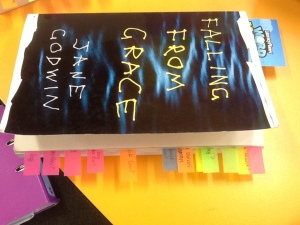 Tomorrow I will be starting a whole class novel study. I encourage my students to tag ideas and write their wonderings as we read. These become fodder for discussions and potential evidence or paragraphs when we start to write about the text. Some students go to the next level and colour code for different characters and/or themes.
Tomorrow I will be starting a whole class novel study. I encourage my students to tag ideas and write their wonderings as we read. These become fodder for discussions and potential evidence or paragraphs when we start to write about the text. Some students go to the next level and colour code for different characters and/or themes.
The best thing about them is that we don’t feel too guilty about putting them into the recycle bin at the end of the session!
* * * * *
How do you use sticky notes?
Bibliophile snobbery!
I am a bibliophile! I not only love to read books but I collect them too. I still have the first book I studied in Year 8 (“All the Green Year” by Don Charlwood) as well as the two books I was allowed to bring with us when we migrated to Australia 35 years ago! I even have multiple copies of some books. My oldest book is about 100 years old and the newest only a few weeks. I am quite excited that the house I am currently renovating is the first house I have owned that is big enough for a library!!
I want my students to love books and reading too. So, I have been giving lots of thinking time to the way we do novel studies.
I still take the traditional approach of selecting a whole class text and then leading the students through a reading and on to an interpretation of themes and features. The problem with this is it is limiting. We can only do 2 or 3 books a year. Not all of the books appeal to all of the students … while I argue that not all books are read for enjoyment, we also learn from books we don’t enjoy (for me, “Hedda Gabler” fits on that list), however for teenagers if we kill the enjoyment we kill the motivation and potentially harm the chances of them reading as adults.
I am also a book snob! I am, after all, a Literature teacher. I want to pay homage to the classics. One of my year 12s recently challenged me to come up with 5 reasons why we should study Shakespeare … of course, he didn’t think I could … of course, he was proven wrong in about 30 seconds!!! I do read new fiction, including teenage fiction (I can’t recommend books if I haven’t read them) but I want to champion the old books that take us back to worlds before we were bombarded with technology (“Brave New World” by Aldous Huxley was shocking when I read it as a 16 year old, and maybe is still a little shocking now that we live with IVF and gene selection technology).
So I have embarked on an adventure. I have allowed my year 8s and 9s to choose their own books for close study this term. They could choose anything (fiction or non-fiction) as long as they could see how they might answer our essential (guiding) question …
What can I learn about life and the world from the books that I read?
I am lucky that I am back in a small rural P-12 school. I have small classes (only 15 students between the two classes). Our school culture encourages teachers to challenge themselves and take risks while trusting that they know their students and know their content.
Before the school holidays the students chose their book and we had our first reading conferences. One student chose “Divergent” by Veronica Roth, which I have read but found frustrating. In our conversation I said I didn’t like the way the society had been divided as it seemed ridiculously artificial just to create a dystopia. I was so annoyed by it I was not inspired to continue reading the series. My student countered my argument by telling me that it was deliberately artificial and unless I read the series I would never know the real reason for the divisions.
Another student chose “Paper Towns” by John Green. I was really reluctant about this choice. I had read 3/4 of ” The Fault in our Stars” and given up. I thought it was lightweight, teenage mush. I expressed my opinion but she had already started it and felt I should give her a chance to prove it was worth her time.
 So, in the holidays I did some reading. I took the advice of the first student and read “Insurgent”. I can’t wait to read “Allegiant” (a task for next weekend). I have a new appreciation for Veronica Roth – the themes /ideas she explores and the way she crafts the story.
So, in the holidays I did some reading. I took the advice of the first student and read “Insurgent”. I can’t wait to read “Allegiant” (a task for next weekend). I have a new appreciation for Veronica Roth – the themes /ideas she explores and the way she crafts the story.
I took the challenge of the second student and read “Paper Towns”. I read it in two days .. all of it! I still won’t be adding it to my list of ‘must reads’ but I did find that it challenged my thinking. I am interested to see what thoughts and wonderings the student had  while she read it.
while she read it.
So, what did I learn about life and the world?
I learnt that sometimes my year 8s are wiser than I am and that I should learn to be less of a book snob! I’m starting to think that in the end it doesn’t matter what we read, we still learn something from the experience.
School starts again tomorrow and we now begin the ‘assignment’. They have compulsory and elective tasks to help guide themselves through their chosen book. In our conferences I will also guide them to see the features and techniques used by the authors, and the themes and connections. The assessment will be an essay responding to the essential question
* * *
How do you promote a love of books and reading in your classroom?
Reading just for fun!
 I have been interested in the Daily 5 / CAFE approach to literacy for some time now. (I am currently reading the second edition of the book). My interest was sparked by conversations in my twitter-feed and the 2 sisters (Gail Boushey and Joan Moser) were presenters at the ALEA conference 2015 (although I was unable to attend the session).
I have been interested in the Daily 5 / CAFE approach to literacy for some time now. (I am currently reading the second edition of the book). My interest was sparked by conversations in my twitter-feed and the 2 sisters (Gail Boushey and Joan Moser) were presenters at the ALEA conference 2015 (although I was unable to attend the session).
Daily 5 is aimed at the primary classroom and I can see how it works in that environment because the class spends a great deal of the day with the same teacher. I am a high school English teacher! So, my challenge has been making the concept work in secondary environment. I see my class three times a week (2 doubles and a single) so the idea of ‘daily’ goes out the window. But surely even a weekly approach would be better than not at all?!?
We do Read to Self every double for 15 minutes (I call it silent reading). I also ask students to read for 15 minutes a night for homework (my students know how I feel about homework). Now that we have finished a term of writer’s notebook I am also happy for students to Work on Writing in this time. (Although I am working towards having 10 minutes of each in each session).
My recent thoughts have been around how to ‘fit in’ Listen to Reading. I have tried class novels before with mixed success. Sometimes the gap of days between seeing the class means they totally forget what we have read. This year I have been trying to promote enjoyment of reading. In year 8 we read our close study novel in class … whole periods, until we finished. In year 9 we read chapters in class and chapters at home … a kind of shared reading … but always had a round table discussion of what we had read. They didn’t do chapter questions or a multi-component assignment.
This term we have no close study text so I suggested I read to them … I would read for 10 minutes each lesson … just for fun! (“You mean we don’t have to do an essay on this book, Miss?”) I had a selection of ‘classics’ I wanted to read. We talked about how you can understand harder books when they are read to you than when you read them yourself. We talked about how important it is to hear words not just see words. We talked about how important it is to develop strategies for remembering what we hear. We also talked about how we won’t like every book we read … we agreed that after each 10 minutes we would decide whether to continue reading or change books.
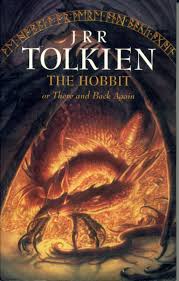 In year 8 we are now 30 minutes into reading The Hobbit! In year 9 we are about to start Destroying Avalon. The students have the choice to just listen or to follow along as I read. They can share ‘wonderings’, ask questions about words and, of course, laugh / moan / react as the story dictates … we are just enjoying reading!
In year 8 we are now 30 minutes into reading The Hobbit! In year 9 we are about to start Destroying Avalon. The students have the choice to just listen or to follow along as I read. They can share ‘wonderings’, ask questions about words and, of course, laugh / moan / react as the story dictates … we are just enjoying reading!
So, I’m not quite hitting the ‘Daily’
but working as hard as I can to fit as many of the ‘5′
in as often as I can!
Weaving Worlds with Words and Wonder – Day 3
 It might have been the last day of the conference but my enthusiasm hadn’t diminished.
It might have been the last day of the conference but my enthusiasm hadn’t diminished.
I have to confess I chose the keynote entirely because of the obvious connection to my favourite picture story book – “Gnashing terrible teeth, ignoring nosy narrators, wondering about wolves and calling Coo-ee across the world – how picture books teach reading lessons and life lessons” presented by John Callow. I have blogged about my use of PSB previously, and I plan to blog some more lesson ideas for secondary teachers. John Callow walked us through a history of PSB and some of the lessons we can give to students. PSB offer the opportunity to read and re-read … it is in the re-reading of familiar texts that we begin to notice the layers of meaning. The modern/post modern PSB sees the author and illustrator working together not “to do each other’s jobs” but to support teach other in creating meaning. I thought I had quite a good collection of PSB (and I certainly had quite a few of the ones Callow mentioned) but I came away with a list of new books to look for. As a high school teacher, if you haven’t got a collection of picture books I ask – why not?
My final session, presented by Chris Walsh, was “How do I teach digital literacies & the Australian Curriculum: Technologies!?” I sat thinking about how PBL and design briefs are cut of the same cloth. I started my career as a Materials (Food and Textiles) teacher, maybe this is why PBL seems so appealing to me even in English and Humanities classrooms. Chris Walsh talked about it being important in “wise, enterprising & challenge-based education” to give students a voice in what they want to learn … in other words, negotiate curriculum and production with them. He introduced the idea of anticipatory thinking as a way of dealing with an uncertain employment future. We know we can’t begin to predict the kinds of jobs our students will do (they haven’t been invented yet) but we need to teach them to think, problem solve and predict (or anticipate) the changes they may face … these ideas resonated with other ideas about promoting creativity that were filtering through the twitter feed (#englit2016) from a concurrent session.
… and then, we were in the plenary with Misty Adoniou! Always entertaining and insightful … she really does love words!! Teachers are courageous (full of heart), wonderful (full of wonder) and need encouragement (to be given more heart). She reminded us that “Good things take time”, we are not one moment but the collection of our career (remember that archive we create?). She suggested we turn things around and instead of trying to fit the good stuff in, start with the good stuff and squeeze the rest in! She left us with this challenge, “Don’t forget the teacher you wanted to become.” “Young pups and old dogs” need to work together to encourage each other and maintain momentum.
So now it’s up to Tassie to match, or better, the learnings and thinkings in 2017. Do yourself a favour and seriously consider attending a conference like this. A national conference offers you a chance to immerse yourself in ideas and surround yourself with like-minded (or at least, equally enthusiastic) people. It is an opportunity to challenge your thinking and recharge your resolve before getting sucked back into the vortex that school life can become. You might not change the World but you might change the world (or space) you and your students learn in.
